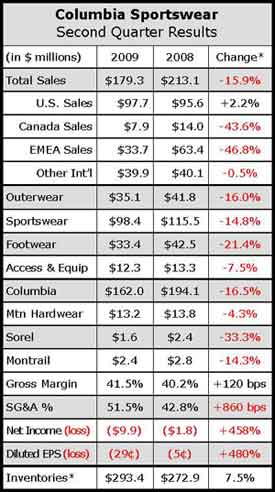Overall, the second quarter for Columbia Sportswear came in better than the outlook the company provided in April due to a smaller decline in net sales than anticipated,along with diligent expense management and the favorable effect of cost control measures that they have implemented over the past year.

Regionally, U.S. sales increased due to Columbias 16 additional U.S. retail stores operating at the end of Q2 2009 as compared to the same period last year. However, U.S. wholesale sales showed a high-single- digit percentage decline, primarily due to the Columbia brands sportswear category. The decrease in U.S. wholesale sales was also due in part to increased order cancellations, credit extension limitations and the bankruptcy of several wholesale customers.
EMEA sales declined due to a five percentage point drag from foreign currency exchange rates. The EMEA distributor business declined in the mid-50% range, reflecting very difficult macroeconomic conditions in Columbias largest distributor regions and a shift in fall shipments into the third quarter from the second quarter. Net sales in Columbias EMEA direct business showed a mid-30% decline, including an 11 percentage point negative effect from foreign currency exchange rates. Columbia expects Fall 2009 to continue to be challenging in this region.
Net sales in Columbias LAAP (Latin America Asia Pacific) region remained essentially flat as foreign currency exchange rates played a significant roll in Japan and Korea. Mid-teens percent growth in Columbias Japan business was aided by a five percentage point gain from the effect of currency. Conversely, the effects of currency on Columbias Korea business turned high 20s percentage constant dollar growth into a 2% decline for the quarter.
Net sales in Canada declined 44% to $7.9 million, including a 10 percentage point currency-based decline. The remaining decrease reflects the soft Spring 2009 order book, which includes the planned reductions in some channels of distribution, as well as increased order cancellations and some shift in the timing of shipments into the third quarter.
Looking at second quarter net sales by product category, Sportswear net sales declines were mostly related to the Columbia brands net sales declines in North America and Europe. Management said that ASPs in apparel were up roughly 10%. Footwear net sales declines were mostly attributable to lower EMEA net sales. The Outerwear net sales decrease was primarily driven by a net sales decline in the EMEA distributor business and was partially offset by net sales increases in the U.S. wholesale retail businesses. Accessories and Equipment net sales decreased $1 million or 8%.
From a brand perspective, the 16% decline in second quarter net sales can be primarily isolated to the Columbia brand which was down $32 million or 17%. Sorel, Montrail and Pacific Trail net sales were insignificant in the second quarter of each year. Mountain Hardwear net sales declined 4%. Mike Wallenfels, president of Mountain Hardwear, told SEW that Q2 is such a small quarter for the brand that it is very susceptible to fluctuations from year to year comps.
SG&A expense increased 870 basis points almost entirely due to direct to consumer sales and marketing initiatives.
These cost increases were partially mitigated by cost reduction initiatives which began in 2008 and included reductions in headcount, incentive compensation, benefits and other discretionary costs.
The net loss for the second quarter of 2009 was $9.9 million or 29 cents per diluted share, compared to a loss of $1.8 million or five cents per diluted share for the second quarter of 2008.
Columbia is maintaining a very strong balance sheet with cash and short term investments totaling $318 million versus $327 million at the same time last year.
Columbia Adds to Owned-Retail…
Third quarter net sales are expected to contract in the low double-digit percent range due to the decrease in fall order backlog reported in April. For the same period, the companys operating margin is expected to contract approximately 650 to 700 basis points from 2008, due to approximately 300 basis points of gross margin contraction and 400 basis points of SG&A expansion.
By the end of 2009, Columbia expects to add a total of 19 stores in North America and Europe and will end 2009 with 48 stores in the U.S., 10 in Europe and 3 in Canada. Management said that they are now looking at how they will go forward with their direct retail business and whether or not “we need to be growing as rapidly as we are today.” Columbias goal is to remain primarily a wholesale business and use its brand stores primarily as a marketing tool.
Columbia continues to anticipate a 15% decline in its combined Fall order backlog, and reaffirmed full-year revenue and operating outlook. Total 2009 net sales are expected to decline in the low double digits on a percentage basis compared to 2008 with the wholesale business down in the mid-teens. Full-year operating margins are expected to decline approximately 300 to 350 basis points from 2008. Columbia is planning its marketing and advertising spend for 2009 as a percentage of sales to be down slightly from 2008 levels.













